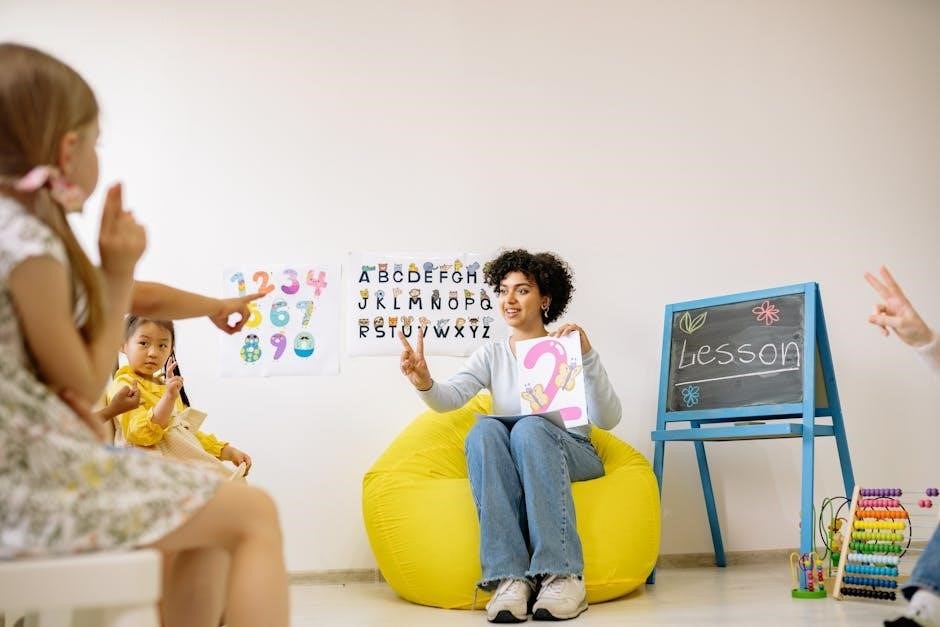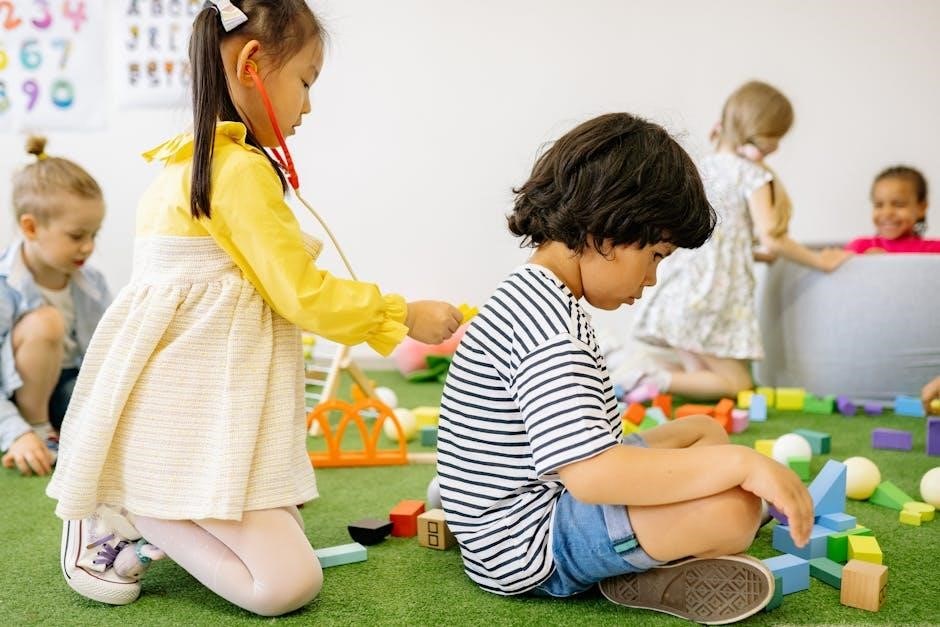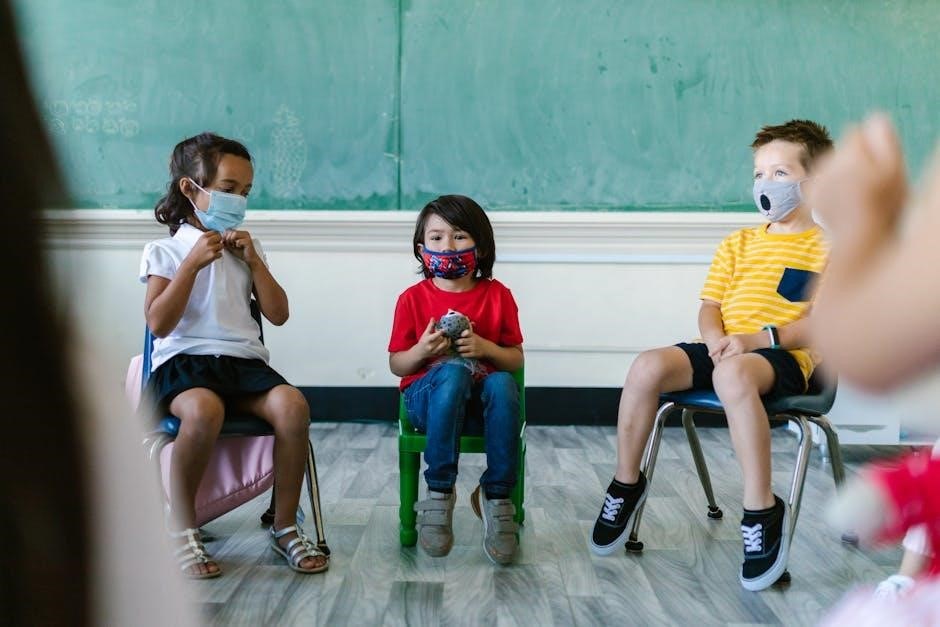A weekly lesson plan for preschool is a structured guide outlining activities, themes, and learning goals․ It helps organize play-based learning, ensuring a balanced and engaging educational experience for young children while fostering essential skills like literacy, creativity, and social interaction․ Using a weekly lesson plan template in PDF format simplifies planning, saves time, and aligns activities with curriculum goals․
1․1 Importance of Structured Weekly Plans

Structured weekly lesson plans are essential for creating a predictable and organized learning environment in preschool․ They ensure consistency, helping young children feel secure and develop routines․ A well-planned schedule allows teachers to cover all necessary skills and topics, promoting holistic development․ It also enables better time management, making sure activities are balanced and engaging․ Structured plans help teachers set clear goals, track progress, and adapt to the needs of their students․ This organization reduces stress for educators and fosters a focused, productive classroom atmosphere․
1․2 Benefits of Using a Preschool Lesson Plan Template
Using a preschool lesson plan template offers numerous benefits, saving time and reducing planning stress․ It provides a clear framework, ensuring consistency and organization in daily activities․ Templates help teachers stay focused on learning objectives while incorporating diverse skills like art, science, and social development․ They also simplify progress tracking and allow for easy customization to meet the unique needs of students; With a template, educators can create engaging, balanced lesson plans efficiently, ensuring a structured and productive learning environment for young children․ This tool is invaluable for both experienced and new teachers․

Structure of a Weekly Preschool Lesson Plan
A weekly preschool lesson plan typically includes a theme, learning objectives, daily activities, materials, and schedules․ It balances play, academics, and skill development for young learners effectively․
2․1 Overview of Key Components
A weekly preschool lesson plan typically includes a theme, learning objectives, daily schedules, and activities․ It outlines materials needed, circle time ideas, and play-based learning opportunities․ The plan also incorporates snacks, outdoor play, and rest periods, ensuring a balanced routine․ Assessment methods and progress tracking are often included to monitor development․ The structure is designed to be flexible, allowing adjustments based on the children’s needs and interests․ This comprehensive approach ensures a cohesive and engaging learning experience tailored to young learners’ developmental stages․
2․2 Theme-Based Learning: How to Choose a Weekly Theme
Choosing a weekly theme for preschool lesson plans involves selecting topics that engage young learners and align with their interests․ Themes like animals, seasons, or community helpers are popular and relatable․ Consider the children’s curiosity and developmental stage to ensure relevance․ Rotate themes to maintain novelty and cater to diverse learning styles․ Incorporate cultural and seasonal variations to broaden exposure․ Align the theme with learning goals to create a cohesive structure․ Involve teachers and parents in theme selection for a collaborative approach․ A well-chosen theme enhances engagement and simplifies lesson planning․
2․3 Setting Clear Learning Objectives
Setting clear learning objectives is essential for effective preschool lesson planning․ Objectives should be specific, measurable, and age-appropriate, focusing on skills like social interaction, emotional growth, and cognitive development․ Align objectives with developmental milestones to ensure relevance․ Use action verbs to define what children will achieve, such as “identify shapes” or “demonstrate sharing․” Break down larger goals into manageable tasks to track progress․ Clear objectives guide activities, assessments, and evaluations, ensuring a focused and purposeful learning experience for young children․ They also help teachers stay organized and ensure continuous skill development․
2․4 Materials and Resources Needed
Identifying the right materials and resources is crucial for a successful preschool lesson plan․ Essential items include art supplies like crayons, markers, and paint, educational toys, puzzles, and building blocks․ Books, flashcards, and sensory materials like play dough and sand are also vital․ Technology tools, such as tablets with educational apps, can enhance learning․ Ensure availability of classroom materials like tables, chairs, and storage bins; Organize resources to promote accessibility and safety, fostering an engaging and inclusive environment for young learners․ Proper materials preparation supports activity execution and learning outcomes․

How to Create a Weekly Lesson Plan
Creating a weekly lesson plan involves outlining the structure, incorporating play-based learning, and ensuring activities align with learning goals․ It promotes organization and engagement in preschool education․
3․1 Step-by-Step Guide to Planning
Start by selecting a weekly theme that aligns with learning goals․ Outline daily activities, ensuring each includes play-based opportunities․ Define clear objectives for skills like alphabet recognition or social interactions․ Schedule circle times, group activities, and outdoor play․ Gather necessary materials in advance․ Incorporate flexibility for unexpected changes․ Review and adjust the plan based on student responses․ Share the plan with colleagues or parents for collaboration and consistency․ This structured approach ensures engaging and effective learning experiences for preschoolers․
3․2 Aligning Activities with Learning Goals
Aligning activities with learning goals ensures purposeful play and skill development․ Begin by identifying clear objectives, such as letter recognition or social skills․ Map each activity to these goals, ensuring relevance․ For example, a sorting game can target math skills․ Use observation and feedback to monitor progress․ Adjust activities as needed to better meet objectives․ Flexibility allows for modifications based on child responses․ This intentional planning fosters meaningful learning experiences tailored to developmental needs, ensuring every activity contributes to overall growth․
3․3 Incorporating Play-Based Learning
Incorporating play-based learning into your weekly lesson plan is essential for preschoolers, as it fosters creativity, imagination, and social skills․ Play-based activities, such as dramatic play, building blocks, and sensory exploration, allow children to learn naturally․ These activities align with child development theories, promoting hands-on experiences that cater to different learning styles․ Plan play opportunities that encourage problem-solving and collaboration, ensuring they are both fun and educational․ This approach keeps children engaged while supporting their cognitive, emotional, and physical growth in a meaningful way․
3․4 Timing and Scheduling Activities
Effective timing and scheduling are critical in a preschool lesson plan․ Activities should be short and flexible, allowing for transitions and free play․ Alternate active and quiet tasks to maintain engagement and prevent overwhelm․ Use visual timers to help children understand time concepts․ Schedule breaks and outdoor play to refresh minds and bodies․ Ensure activities align with attention spans, typically 10-15 minutes for preschoolers․ Consistent routines provide a sense of security, while flexibility accommodates unexpected moments․ Balancing structure and adaptability ensures a smooth and productive learning environment․

Tips for Customizing Your Lesson Plan
Customize lesson plans by adapting activities to children’s interests and developmental levels․ Incorporate feedback from students and parents to tailor content effectively․ Use flexible scheduling and varied teaching methods to meet diverse needs while maintaining engagement and inclusivity․
4․1 Adapting for Different Age Groups
When creating a weekly lesson plan for preschool, consider the developmental stages of your students․ For infants, focus on sensory play and motor skills․ Toddlers benefit from simple, repetitive activities that encourage language and social interaction․ Preschoolers can engage in more structured tasks, such as alphabet recognition and basic math, while pre-kindergartners need activities that build independence and problem-solving skills; Tailor activities to align with each age group’s abilities and interests to ensure engagement and developmental appropriateness․ This approach fosters a nurturing environment where every child can thrive;
4․2 Meeting Diverse Learning Needs
Meeting diverse learning needs in preschool requires a tailored approach, ensuring each child’s unique abilities are supported․ Strategies include using visual aids, hands-on activities, and assistive technology to engage different learners․ Differentiated instruction allows teachers to cater to individual learning styles․ Collaboration with specialists and involving parents further enhance the support system, creating an inclusive environment that fosters growth and development for all children․
4․3 Flexibility in Planning
Flexibility in planning allows teachers to adapt activities based on children’s interests and unexpected opportunities․ It ensures lesson plans remain engaging and relevant, while still aligning with learning objectives․ Teachers can adjust timelines, incorporate spontaneous ideas, or modify activities to suit the class’s mood․ Reflecting on daily outcomes helps in making informed adjustments for upcoming sessions, fostering a dynamic and responsive learning environment that caters to the unique needs of preschoolers․

Using a Preschool Lesson Plan Template
Using a preschool lesson plan template streamlines preparation, ensuring consistency and alignment with educational goals․ It offers flexibility for customization, supporting diverse learning needs and saving time․
5․1 Features of a Good Template
A good preschool lesson plan template should be user-friendly, customizable, and aligned with educational goals․ It should include sections for learning objectives, activities, materials, and assessments․ A visually appealing design with space for notes and flexibility to adapt to different themes or age groups is essential․ The template should also incorporate areas for tracking progress and reflecting on lessons․ Additional features like built-in schedules, activity ideas, and alignment with curriculum standards can enhance its effectiveness․ A well-designed template ensures consistency and helps teachers deliver engaging, structured lessons․
5․2 Free vs․ Premium Templates
Free templates are ideal for teachers on a budget, offering basic structures for lesson planning․ They are widely available and easy to access but may lack customization options․ Premium templates, while requiring a purchase, provide advanced features like customizable layouts, exclusive designs, and additional resources․ They often include editable fields, high-quality graphics, and comprehensive planning tools․ Premium templates are more versatile, catering to diverse teaching styles and classroom needs․ Both options serve their purposes, but premium templates offer enhanced functionality for a more polished and professional lesson plan․
5․3 Where to Find Printable Templates
Printable preschool lesson plan templates are widely available online․ Websites like Teachers Pay Teachers, Pinterest, and Google Drive offer a variety of free and premium templates․ Educational blogs and platforms specializing in preschool resources also provide downloadable options․ Additionally, many schools and educational institutions share their own templates publicly․ These templates are designed to be user-friendly and adaptable to different teaching styles, ensuring accessibility for all educators seeking to organize their weekly lesson plans effectively․
5․4 How to Edit and Customize Templates
To customize preschool lesson plan templates, download the PDF and open it in Adobe Acrobat or Google Docs․ Replace placeholders with specific content, such as themes, activities, and learning objectives․ Add or remove sections based on your needs․ Customize fonts, colors, and layouts for a personalized touch․ Insert images or school logos for branding․ Share templates with colleagues for collaboration․ Save the edited version for future use, ensuring it aligns with your teaching style and classroom requirements․ This process allows for flexibility and ensures the template meets your unique planning needs․

Activities and Ideas for Weekly Plans
Engage preschoolers with diverse activities promoting learning through play, creativity, and social interaction․ Incorporate songs, stories, art, and exploration to foster curiosity and developmental growth․
6․1 Circle Time and Group Activities
Circle time fosters social interaction and learning through songs, stories, and group discussions․ Use this time to introduce themes, teach new vocabulary, and encourage participation․ Incorporate movement activities like clapping or dancing to keep children engaged․ Group games and collaborative tasks promote teamwork and problem-solving skills․ Reading aloud from colorful books sparks imagination and language development․ Ensure activities are age-appropriate and varied to cater to different interests and learning styles, creating a positive and inclusive environment for all preschoolers․
6․2 Small Group and Center Activities
Small group and center activities allow preschoolers to explore and learn through hands-on experiences․ Centers like art stations, building blocks, and sensory bins encourage creativity and skill development․ These activities are designed to cater to different learning styles and interests․ Teachers can rotate children through centers to ensure balanced engagement․ Small groups enable personalized attention and foster collaboration․ Activities are often themed to align with weekly lesson plans, promoting deeper understanding and application of concepts in a fun, interactive manner․
6․3 Outdoor and Indoor Play Ideas
Outdoor and indoor play ideas are essential for preschoolers’ physical and cognitive development․ Outdoor activities like nature walks, scavenger hunts, and bubble play promote exploration and gross motor skills․ Indoor options such as dramatic play, puppet shows, or music sessions foster creativity and social interaction․ Rotating activities seasonally ensures variety and engagement․ Weather-friendly alternatives, like indoor obstacle courses, keep children active year-round․ These play ideas align with weekly themes, making learning fun and interactive while adapting to different environments and needs․
6․4 Art and Craft Projects
Art and craft projects are vital for fostering creativity and fine motor skills in preschoolers․ Activities like painting, drawing, and creating with play dough encourage self-expression․ Seasonal crafts, such as making paper flowers or holiday-themed art, align with weekly themes․ Recycling materials, like turning bottle caps into collages, teaches sustainability․ Simple, age-appropriate projects ensure inclusivity, allowing all children to participate and feel accomplished․ These activities not only enhance creativity but also reinforce learning objectives, making them a valuable part of weekly lesson plans․

Assessing and Reflecting on the Lesson Plan
Assessment involves observing children’s progress, reviewing their work, and gathering feedback to refine future plans․ Reflection helps teachers evaluate effectiveness and make necessary adjustments for better outcomes․
7․1 Tracking Progress and Development
Tracking progress involves regularly observing and documenting children’s skills and achievements․ Teachers use checklists, portfolios, and informal assessments to monitor developmental milestones․ This helps identify areas where children may need extra support․ By maintaining detailed records, educators can tailor activities to meet individual needs and celebrate growth over time․ Regular updates also provide valuable insights for parents and help in planning future lessons effectively․
7․2 What Worked and What Didn’t
Evaluating the effectiveness of a lesson plan involves reflecting on what worked well and what didn’t․ Teachers assess which activities engaged the children, aligned with learning goals, and fostered development․ They also identify areas that were challenging or less effective․ By analyzing feedback from students and colleagues, educators can refine their strategies, improving future lessons․ This reflection process helps in adjusting approaches to better meet the needs of the children and enhance overall learning experiences․
7․3 Involving Parents and Families
Involving parents and families in preschool lesson plans fosters a collaborative learning environment․ Sharing weekly plans through newsletters, emails, or parent-teacher apps keeps them informed․ Parents can reinforce learning at home by participating in activities or projects․ Encouraging feedback helps tailor plans to better support children․ Building strong partnerships ensures consistency between school and home, promoting overall child development and strengthening the connection between educators and families․

Tools and Resources for Lesson Planning
Digital tools like Google Classroom, educational apps, and printable worksheets enhance preschool lesson planning․ These resources streamline organization, engagement, and creativity, supporting teachers effectively․
8․1 Digital Tools for Teachers
Digital tools simplify preschool lesson planning by offering templates, activity ideas, and organization features․ Platforms like Google Classroom and PlanBook enable teachers to schedule lessons, share resources, and track progress․ Educational apps such as ABCmouse and Khan Academy Kids provide interactive activities aligned with learning goals․ Additionally, tools like Trello and Evernote help organize materials and collaborate with colleagues․ These digital solutions enhance efficiency, creativity, and engagement, making weekly lesson planning more manageable and effective for preschool educators․
8․2 Printable Worksheets and Worksheets
Printable worksheets are essential for preschool lesson plans, offering structured activities that reinforce learning objectives․ They include alphabet tracing, number recognition, and color matching exercises․ Websites like Teachers Pay Teachers and Etsy provide themed worksheets that align with weekly topics․ These resources save time and cater to different learning styles․ Many worksheets are customizable, allowing teachers to adapt them to their classroom needs․ They also serve as valuable take-home materials for parents to support continuous learning outside the classroom environment․
8․3 Educational Apps for Preschoolers
Educational apps are valuable tools for preschool lesson plans, offering interactive and engaging learning experiences․ Apps like ABCmouse, Khan Academy Kids, and Toca Life provide games, puzzles, and creative activities that align with weekly themes․ They cater to various learning styles and skill levels, making learning fun and accessible․ Many apps are designed for classroom use or as homework extensions, allowing teachers to integrate technology seamlessly․ These resources are often free or low-cost, making them accessible to educators and families, while enhancing cognitive and motor skills in young learners․

Benefits of Weekly Lesson Plans
Weekly lesson plans improve organization, ensure consistent learning, and align activities with goals, enhancing preschoolers’ development and engagement while streamlining teaching processes effectively․
9․1 Improved Organization and Time Management
Weekly lesson plans significantly enhance organization and time management for preschool teachers․ By outlining daily activities and learning goals in advance, educators can allocate time more effectively, ensuring a balanced curriculum․ This structure helps in preparing materials, transitioning smoothly between activities, and maintaining consistency․ Teachers can focus on engaging students rather than scrambling for last-minute preparations; Improved organization also reduces stress and allows for better use of classroom time, creating a more efficient and productive learning environment for young children․
9․2 Enhanced Learning Outcomes
Weekly lesson plans play a crucial role in enhancing learning outcomes for preschoolers․ By providing a structured and intentional approach to teaching, these plans ensure that developmental goals are consistently addressed․ Activities are aligned with learning objectives, promoting skill mastery in areas such as social, emotional, and cognitive development․ Consistency in instruction fosters a predictable environment, helping children build confidence and understanding․ Additionally, tracking progress through weekly plans allows teachers to identify strengths and areas for growth, ensuring each child receives tailored support for optimal development․
9․3 Reduced Teacher Stress
Weekly lesson plans significantly reduce teacher stress by providing a clear roadmap for instruction․ Knowing what needs to be accomplished each day eliminates last-minute planning and uncertainty․ Organized materials and structured activities save time, allowing teachers to focus on engaging with students․ Consistency in planning also helps manage classroom dynamics, reducing chaos and fostering a calm learning environment․ This sense of preparedness boosts confidence and lowers anxiety, enabling teachers to create a more positive and productive experience for both themselves and their students․
10․1 Summary of Key Points
A well-structured weekly lesson plan for preschool is essential for fostering young learners’ cognitive, social, and emotional growth․ It ensures organized activities, aligns with developmental goals, and incorporates play-based learning․ Using templates simplifies planning, while flexibility allows for adapting to diverse needs․ Themes and clear objectives guide meaningful experiences, and reflections help assess progress; Consistent planning supports teachers in creating engaging environments, promoting better learning outcomes and reducing stress․ Ultimately, a thoughtfully designed plan enriches both teaching and learning experiences for preschoolers․
10․2 Final Tips for Successful Lesson Planning
Stay flexible and adapt plans to meet children’s needs and interests․ Prioritize fun and engagement to foster a love for learning․ Incorporate hands-on activities and play to promote skill development․ Align plans with developmental goals while encouraging creativity․ Regularly seek feedback from colleagues and parents to refine strategies․ Keep activities simple, interactive, and age-appropriate․ Lastly, maintain a positive and inclusive classroom environment that nurtures curiosity and growth․ Consistent, thoughtful planning ensures a successful and enjoyable learning experience for preschoolers․
